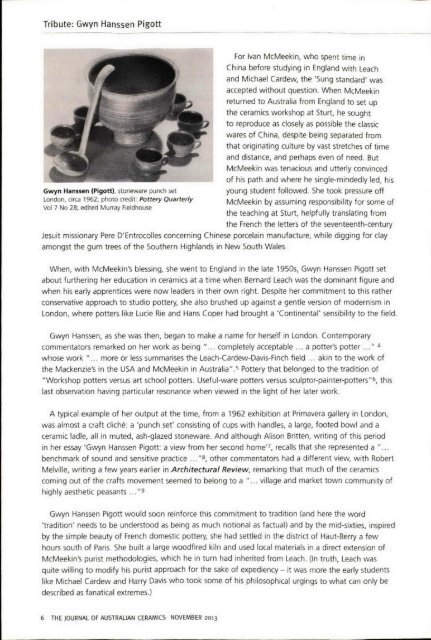The Journal of Australian Ceramics Vol 52 No 3 November 2013
You also want an ePaper? Increase the reach of your titles
YUMPU automatically turns print PDFs into web optimized ePapers that Google loves.
Tribute: Gwyn Hanssen Pigott<br />
Gwyn Hanssen (Pigott), stoneware punch set<br />
London, circa 1962: photo credit: Pottery Quarterly<br />
<strong>Vol</strong> 7 <strong>No</strong> 28; edited Murray Fieldhouse<br />
For Ivan McMeekin, who spent time in<br />
China before studying in England with Leach<br />
and Michael Cardew, the 'Sung standard' was<br />
accepted without question. When MCMeekin<br />
returned to Australia from England to set up<br />
the ceramics workshop at Sturt, he sought<br />
to reproduce as closely as possible the classic<br />
wares <strong>of</strong> China, despite being separated from<br />
that originating culture by vast stretches <strong>of</strong> time<br />
and distance, and perhaps even <strong>of</strong> need. But<br />
McMeekin was tenacious and utterly convinced<br />
<strong>of</strong> his path and where he single-mindedly led, his<br />
young student followed. She took pressure <strong>of</strong>f<br />
McMeekin by assuming responsibility for some <strong>of</strong><br />
the teaching at Sturt, helpfully translating from<br />
the French the letters <strong>of</strong> the seventeenth-century<br />
Jesuit missionary Pere D'Entrocolles concerning Chinese porcelain manufacture, while digging for clay<br />
amongst the gum trees <strong>of</strong> the Southern Highlands in New South Wales.<br />
When, with McMeekin's blessing, she went to England in the late 1950s, Gwyn Hanssen Pigott set<br />
about furthering her education in ceramics at a time when Bernard Leach was the dominant figure and<br />
when his early apprentices were now leaders in their own right. Despite her commitment to this rather<br />
conservative approach to studio pottery, she also brushed up against a gentle version <strong>of</strong> modernism in<br />
London, where potters like Lucie Rie and Hans Coper had brought a 'Continental' sensibility to the field.<br />
Gwyn Hanssen, as she was then, began to make a name for herself in London. Contemporary<br />
commentators remarked on her work as being" ... completely acceptable .. a potter's potter .. ." 4<br />
whose work" ... more or less summarises the Leach-Cardew-Davis-Finch field .. akin to the work <strong>of</strong><br />
the Mackenzie's in the USA and McMeekin in Australia" S Pottery that belonged to the tradition <strong>of</strong><br />
"Workshop potters versus art school potters. Useful-ware potters versus sculptor-painter-potters"6, this<br />
last observation having particular resonance when viewed in the light <strong>of</strong> her later work.<br />
A typical example <strong>of</strong> her output at the time, from a 1962 exhibition at Primavera gallery in London,<br />
was almost a craft cliche: a 'punch set' consisting <strong>of</strong> cups with handles, a large, footed bowl and a<br />
ceramic ladle, all in muted, ash-glazed stoneware. And although Alison Britten, writing <strong>of</strong> this period<br />
in her essay 'Gwyn Hanssen Pigott: a view from her second home", recalls that she represented a " ..<br />
benchmark <strong>of</strong> sound and sensitive practice .."8, other commentators had a different view, with Robert<br />
Melville, writing a few years earlier in Architectural Review, remarking that much <strong>of</strong> the ceramics<br />
coming out <strong>of</strong> the crafts movement seemed to belong to a " ... village and market town community <strong>of</strong><br />
highly aesthetic peasants .. ."9<br />
Gwyn Hanssen Pigott would soon reinforce this commitment to tradition (and here the word<br />
'tradition' needs to be understood as being as much notional as factual) and by the mid-sixties, inspired<br />
by the simple beauty <strong>of</strong> French domestic pottery, she had settled in the district <strong>of</strong> Haut-Berry a few<br />
hours south <strong>of</strong> Paris . She built a large woodfired kiln and used local materials in a direct extension <strong>of</strong><br />
McMeekin's purist methodologies, which he in turn had inherited from Leach. (In truth, Leach was<br />
quite willing to modify his purist approach for the sake <strong>of</strong> expediency - it was more the early students<br />
like Michael Cardew and Harry Davis who took some <strong>of</strong> his ph ilosophical urgings to what can only be<br />
described as fanatical extremes.)<br />
6 THE JOURNAL OF AUSTRALIAN CERAMICS NOVEMBER <strong>2013</strong>

















